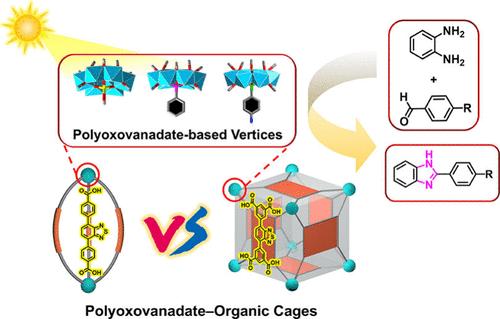Structural Engineering in Polyoxovanadate–Organic Cages toward Photocatalytic Synthesis of Benzimidazoles
IF 7
2区 材料科学
Q2 CHEMISTRY, PHYSICAL
引用次数: 0
Abstract
Photocatalytic fabrication of fine chemicals provides a sustainable method of development for the pharmaceutical industry. At present, optimizing the performance of photocatalysts via precise structural engineering at the atomic level is of the utmost importance. To unleash the potential of structurally editable polyoxovanadate–organic cages (POV-MOCs) as photocatalytic materials, herein, a family of five POV-MOCs were scaffolded by a cross combination of {V6X} (X = SO42–, PhPO32–, and NH2PhAsO32–) vertices and benzo-2,1,3-thiadiazole-functionalized carboxylate linkers. Along with the structural evolution from capsule to cuboid-type topology as well as the heterogroup modification of the vertex, the photophysical properties of POV-MOCs could be regulated precisely. The structurally optimized POV-MOCs demonstrated prominent photocatalytic activity in the oxidative synthesis of benzimidazoles, which are medicinally important. Thanks to the teamwork of experimental and theoretical studies, a possible reaction mechanism that involves O2•– has been proposed and validated. The unveiled structure–function relationship provides an effective route to customize POV-MOC-based photocatalysts for a broader range of sustainable applications.

聚钒氧酸盐-有机笼光催化合成苯并咪唑的结构工程
光催化制备精细化学品为制药工业提供了可持续发展的途径。目前,通过精确的结构工程在原子水平上优化光催化剂的性能是至关重要的。为了释放结构可编辑的聚钒氧酸有机笼(POV-MOCs)作为光催化材料的潜力,本文通过{V6X} (X = SO42 -, PhPO32 -和NH2PhAsO32 -)顶点和苯并-2,1,3-噻二唑功能化羧酸盐连接剂的交叉组合构建了一个5个POV-MOCs家族。随着pov - moc结构从胶囊型向长体型的演变以及顶点的异质基团修饰,pov - moc的光物理性质可以被精确调控。结构优化后的POV-MOCs在苯并咪唑的氧化合成中表现出突出的光催化活性,具有重要的药用价值。通过实验和理论研究的团队合作,提出并验证了一种可能涉及O2•-的反应机制。揭示的结构-功能关系为定制基于pov - moc的光催化剂提供了一条有效的途径,以实现更广泛的可持续应用。
本文章由计算机程序翻译,如有差异,请以英文原文为准。
求助全文
约1分钟内获得全文
求助全文
来源期刊

Chemistry of Materials
工程技术-材料科学:综合
CiteScore
14.10
自引率
5.80%
发文量
929
审稿时长
1.5 months
期刊介绍:
The journal Chemistry of Materials focuses on publishing original research at the intersection of materials science and chemistry. The studies published in the journal involve chemistry as a prominent component and explore topics such as the design, synthesis, characterization, processing, understanding, and application of functional or potentially functional materials. The journal covers various areas of interest, including inorganic and organic solid-state chemistry, nanomaterials, biomaterials, thin films and polymers, and composite/hybrid materials. The journal particularly seeks papers that highlight the creation or development of innovative materials with novel optical, electrical, magnetic, catalytic, or mechanical properties. It is essential that manuscripts on these topics have a primary focus on the chemistry of materials and represent a significant advancement compared to prior research. Before external reviews are sought, submitted manuscripts undergo a review process by a minimum of two editors to ensure their appropriateness for the journal and the presence of sufficient evidence of a significant advance that will be of broad interest to the materials chemistry community.
 求助内容:
求助内容: 应助结果提醒方式:
应助结果提醒方式:


